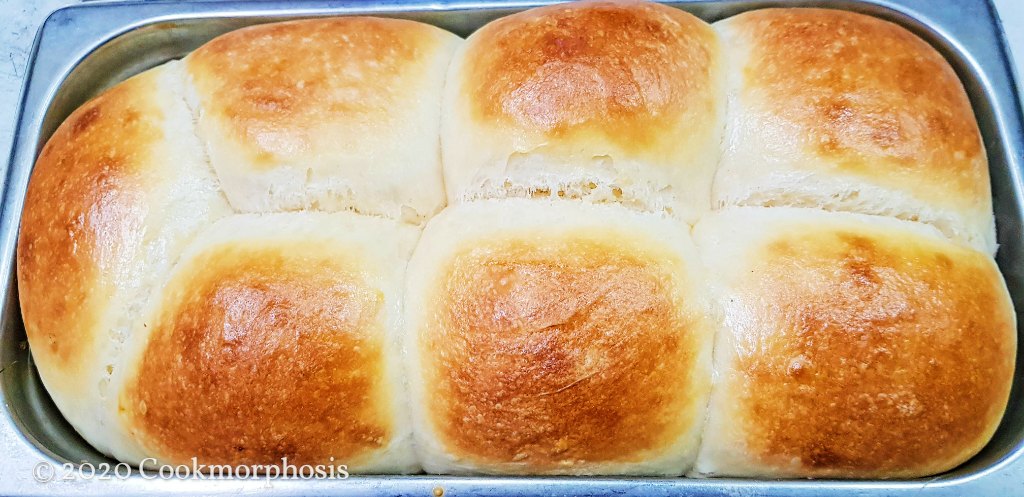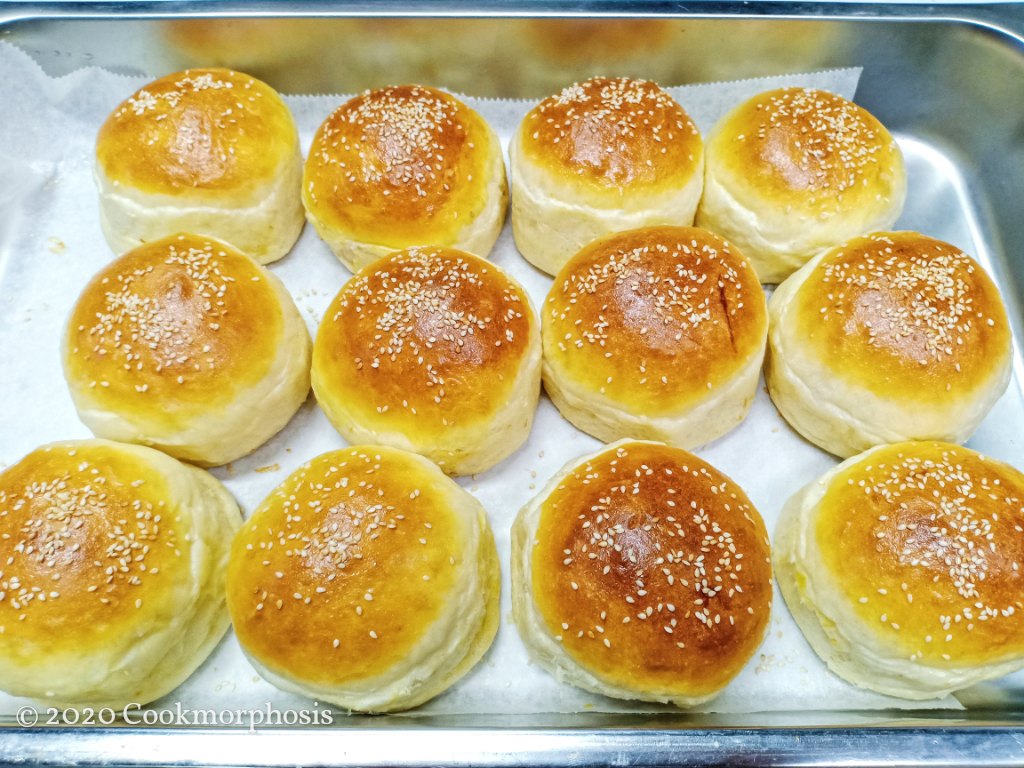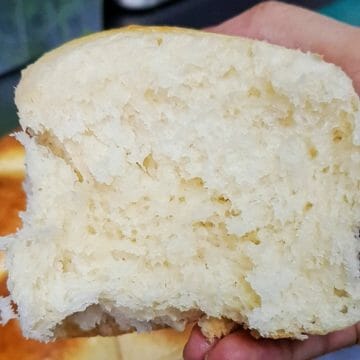A beginner's guide for making no-knead classic brioche buns: appealing golden color, tender crumb and rich in flavors.

This no-knead classic brioche buns recipe was widely used in my latest restaurant. I've implemented this for all of our soft buns options including: burgers, hot dogs, and last but not least dinner rolls; and everything came out perfectly. This was already commercially tested so I promise your brioche buns will turn out super tender and rich in flavors.
You don't need to be a professional baker to master this recipe because it requires no bread kneading's techniques at all; but you still need to mix everything in order to incorporate them completely. Just give a dough a few round of of mixing, then it will be good to go.
What is brioche?
Brioche is a rich bread made with a generous amount of eggs and butter. Because of its high ratio in fat, it is quite difficult to work with but the end result is well worth the extra effort.
Difference between knead and no-knead method
Traditionally, any brioche recipe asks for a very labor intense and patient process due to it rich in butter. The process requires softened butter to be added and kneaded into the dough gradually and smoothly. Only after one portion of butter is fully incorporated then the next one will be added. This will prevent the dough from separating. And this is called kneading method and can only be achieved by the help of stand mixer.
No-knead brioche means we avoid the use of stand mixing by using melted butter instead of softened butter. This method allows us to simplify the traditional mixing brioche method. No-knead brioche recipe can be achieved by mixing all ingredients by hands or by spatula in a mixing bowl. And no extra kneading required after all.

What's to notice in this no-knead classic brioche buns?
Here are what you need to do in order to achieve such a soft, moist, and fluffy texture for all of your soft buns:
- Only use bread flour - bread flour provides more structure to this rich in fat brioche buns. Compared to all-purpose flour which has lower percentage of protein, bread flour ensures strong gluten development and structure building properties. King Arthur bread flour is still the number one choice among Chefs and Bakers. If you can get a hand on this precious product, go for it.
- Only melt butter on small/medium heat, do not bring to boil - then add the milk and carefully stir the mixture to incorporate. If you boil the butter from the beginning and then add the milk at high heat, the mixture will be separated.
- I prefer using instant rise yeast in this recipe - or also called rapid-rise yeast because it does not need to be proofed and can be added directly to the dough mix.
- Be patient and let the dough proof - this process has two parts
- The first proof happens right after you mix all ingredients together.
- The second proof is after you finish forming the dough into your bun's desired shape.
Fermentation/proofing is complete when the dough has approximately doubled in size and no longer springs back when pressed gently with two fingers. The time necessary varies depending on the temperature of the dough and the temperature of the room.

Ingredients used in this beginner's guide for no-knead classic brioche buns
- Bread flour - I'm using King Arthur Unbleached Bread Flour which has 12.7% protein. King Arthur has never disappoint me in terms of bread baking. It strengthens the rise, so the breads are lofty and perfectly textured every time.
- Instant rise yeast - SAF gold instant yeast should always be your top pick. It is the world's top selling instant yeast.
- Sugar, unsalted butter, and whole milk
Choosing and storing yeast
As mentioned above, I recommend using SAF gold instant yeast, it is famous among professional bakers due to its professional grade yeast. However, SAF has 2 types of instant yeast: Gold and Red. The difference between SAF gold instant yeast and red instant yeast is: The SAF gold instant yeast is formulated to be used in a sweet dough that contains a sugar content 10% or higher to the weight of flour. That being said, the gold version is more suitable for this brioche recipe.
If instant rise yeast is not available to you, you can substitute it for active rise yeast in a recipe, just use 25% less of the required amount.
The best way to store yeast is in an air tight container in the refrigerator or freezer to slow its deterioration for up to a year.
Proofing temperature
- If you're using instant dry yeast, the best temperature to proof the dough is at 85F - 100F (29C - 38C).
- If you're using active dry yeast, the best temperature to proof the dough is at 100F - 110F (38C - 40C).
- Anything above 136F (58C) will kill the yeast.
Brioche variations
Brioche is traditionally baked in fluted pans and has a cap or topknot of dough. However, you can also shape and bake this brioche dough into:
- Burger buns (which is used in this recipe): this can be paired with this amazing, delicious grilled Cajun chicken sandwich
- Hot dog buns
- Brioche loaf
- Dinner rolls
Steps in making this brioche recipe
- Scaling the ingredients
- Mixing the dough
- Proofing the dough for the first time (this stage is also called fermentation)
- Punching the dough down
- Portioning the dough
- Rounding & shaping the dough to desire's shape
- Proofing the dough for the second time
- Baking the buns
- Cooling and eating the finished buns
Well, enough with all of the theory, lets go the most exciting part, shall we? Lady & gentlemen, I hereby present to you: the ultimate no-knead dough for any kind of soft buns.

No-knead classic brioche buns
Equipment
- Half sheet or full sheet pan or sandwich loaf pan
- Parchment paper
- Baking brush
- Cooking scale
- Cooking oil spray
Ingredients
Dough
- 21 oz bread flour
- 3.5 oz sugar
- 1 tbsp yeast
- ¼ c warm water
- 1 c whole milk
- 2 oz butter melted
- 2 large eggs beaten
Add-on
- white sesame seeds as needed if making burger buns
Egg wash
- 1 egg yolks beaten
- 1 tbsp milk
Instructions
- Combine the water and yeast in a small bowl. Combine the remaining ingredients in another mixing bowl.
- Add the water-yeast mixture to the remaining ingredients.
- Use your hands or a spoon and stir all the ingredients to combine.
- Transfer the dough to a lightly greased mixing bowl (you can use cooking spray), cover and place in a warm spot. Ferment until doubled, approximately 1 to 1.5 hour.
- Punch down the dough. Let it rest a few minutes to allow the gluten to relax.
- Divide the dough into 1.4 oz (40gr) portion. Shape as desired and arrange on paper-lined sheet pans. Proof again until doubled in size.
- Carefully brush the proofed rolls with egg wash (sprinkle white sesame on top of the buns if making burgers). Bake at 375F (190C) until medium brown for approximately 12 to 15 minutes for burgers and hot dog buns; 35 to 45 minutes for dinner rolls.

Hi, Tu
I would like to make this Brioche Buns but I've a few questions that I hope you can help with? Do u have the ingredients in grams? Can add fillings? Use low fat/skim milk? How long does it take to stir all the ingredients to combine?
Thank you n looking forward to your reply.🌷
Hey Lilyn,
Thank you for being interested in making these buns. They are so amazing, you will love them. As for the metric measurements, I've just edited and added them to the recipe for your reference. You can use skim milk instead of whole milk; remember that the buns will not taste as rich as they should. Stirring time will also differ depending on many factors: your kitchen temperature, mixing speed, and ingredients quality ... As for me, it took under 2 minutes (using a spoon/whisk). As for the fillings, I have yet to make one using this recipe, but you can try it. You can add the filling to the dough while shaping them individually (step 6). Feel free to let me know if you still need any more troubleshooting. I'm happy to help.